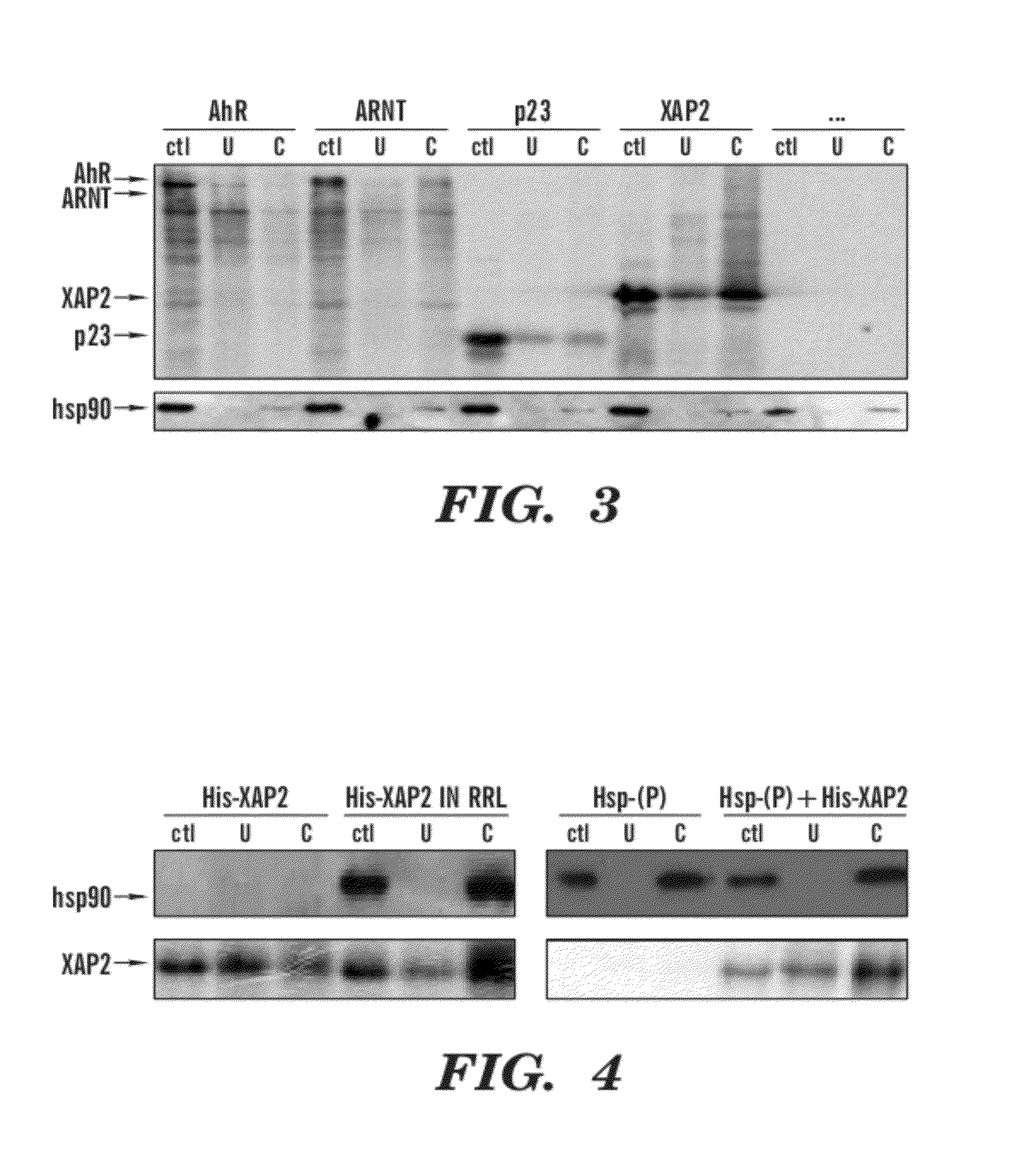Methods of inhibiting the activity of hsp90 and/or aryl hydrocarbon receptor
a technology of aryl hydrocarbon receptor and hsp90, which is applied in the field of inhibiting the activity of hsp90 and/or aryl hydrocarbon receptor, can solve the problem that the dim-bound complex is incapable of recruiting the necessary co-factors responsible for initiating transcription, and not the cas
- Summary
- Abstract
- Description
- Claims
- Application Information
AI Technical Summary
Benefits of technology
Problems solved by technology
Method used
Image
Examples
example 1
EGCG Inhibits TCDD Induced Gene Expression
[0104]Although it has previously been demonstrated that EGCG alters transcription of a DRE-dependent reporter gene (Palermo et al., Chem. Res. Toxicol. 16:865-872 (2003), which is hereby incorporated by reference in its entirety), it was important to assess the ability of EGCG to influence an endogenous AhR-regulated gene. To do this, the effect of EGCG on CYP1A1 expression in mouse hepatoma cells was determined. CYP1A1 is highly expressed in this cell type and is known to be transcriptionally induced upon ligand activation of the AhR (Whitlock, Annu. Rev. Pharmacol. Toxicol. 39:125 (1999), which is hereby incorporated by reference in its entirety). As shown in FIG. 1A, treatment alone with EGCG had no effect on CYP1A1 gene induction. However, treatment of cells simultaneously with EGCG and TCDD showed a concentration-dependent inhibition of TCDD-mediated CYP1A1 gene induction. These data support the hypothesis that EGCG is an AhR antagonist...
example 2
EGCG Does Not Compete for Binding to the AhR Ligand Binding Domain
[0106]There are many possible mechanisms by which EGCG may function to inhibit TCDD-mediated gene induction. Previous findings suggest that flavonoid antagonists function through direct competition for binding to the TCDD ligand binding site on the AhR (Henry et al., Mol. Pharmacol. 55:716-725 (1999), which is hereby incorporated by reference in its entirety). This binding of antagonist is believed to result in an AhR conformation incapable of nuclear translocation, DRE binding, and transcriptional enhancement. It was therefore hypothesized that EGCG exerts its effects through an identical mechanism involving direct binding to the AhR ligand-binding site.
[0107]Velocity sedimentation of the AhR on sucrose density gradients was used to determine if EGCG could inhibit the specific binding of TCDD to the mouse AhR. This methodology was chosen over other binding assays because it provides a reliable measure of specific bin...
example 3
Hsp90 and XAP2 are Eluted From EGCG-Conjugated Sepharose Beads
[0110]Based on the above competitive binding experiments, it is unlikely that EGCG is binding to the TCDD ligand-binding site on the AhR. This suggests that EGCG is either binding another site on the AhR or is affecting AhR activity through an indirect mechanism, perhaps involving binding to another protein in the AhR complex such as hsp90, XAP2, p23, or ARNT. To address these possibilities affinity chromatography was performed using EGCG-conjugated Sepharose. XAP2, ARNT, p23, and AhR proteins were separately transcribed in vitro in the presence of 35S-methionine and incubated with either unconjugated Sepharose or EGCG-Sepharose. Binding of these proteins to the Sepharose beads was assessed by Phosphoimaging following SDS-PAGE of the eluted protein. Hsp90 is inherent to RRL, therefore the ability of this protein to bind EGCG was assessed by immunoblotting. As shown in FIG. 3, in vitro translated AhR was not able to bind i...
PUM
| Property | Measurement | Unit |
|---|---|---|
| size | aaaaa | aaaaa |
| size | aaaaa | aaaaa |
| pH | aaaaa | aaaaa |
Abstract
Description
Claims
Application Information
 Login to View More
Login to View More - R&D
- Intellectual Property
- Life Sciences
- Materials
- Tech Scout
- Unparalleled Data Quality
- Higher Quality Content
- 60% Fewer Hallucinations
Browse by: Latest US Patents, China's latest patents, Technical Efficacy Thesaurus, Application Domain, Technology Topic, Popular Technical Reports.
© 2025 PatSnap. All rights reserved.Legal|Privacy policy|Modern Slavery Act Transparency Statement|Sitemap|About US| Contact US: help@patsnap.com



